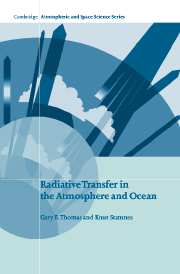Book contents
- Frontmatter
- Contents
- List of Illustrations
- Preface
- Acknowledgments
- Chapter 1 Basic Properties of Radiation, Atmospheres, and Oceans
- Chapter 2 Basic State Variables and the Radiative Transfer Equation
- Chapter 3 Basic Scattering Processes
- Chapter 4 Absorption by Solid, Aqueous, and Gaseous Media
- Chapter 5 Principles of Radiative Transfer
- Chapter 6 Formulation of Radiative Transfer Problems
- Chapter 7 Approximate Solutions of Prototype Problems
- Chapter 8 Accurate Numerical Solutions of Prototype Problems
- Chapter 9 Shortwave Radiative Transfer
- Chapter 10 Transmission in Spectrally Complex Media
- Chapter 11 Radiative Transfer in Nongray Media
- Chapter 12 The Role of Radiation in Climate
- Appendices
- Index
Chapter 9 - Shortwave Radiative Transfer
Published online by Cambridge University Press: 18 December 2009
- Frontmatter
- Contents
- List of Illustrations
- Preface
- Acknowledgments
- Chapter 1 Basic Properties of Radiation, Atmospheres, and Oceans
- Chapter 2 Basic State Variables and the Radiative Transfer Equation
- Chapter 3 Basic Scattering Processes
- Chapter 4 Absorption by Solid, Aqueous, and Gaseous Media
- Chapter 5 Principles of Radiative Transfer
- Chapter 6 Formulation of Radiative Transfer Problems
- Chapter 7 Approximate Solutions of Prototype Problems
- Chapter 8 Accurate Numerical Solutions of Prototype Problems
- Chapter 9 Shortwave Radiative Transfer
- Chapter 10 Transmission in Spectrally Complex Media
- Chapter 11 Radiative Transfer in Nongray Media
- Chapter 12 The Role of Radiation in Climate
- Appendices
- Index
Summary
Introduction
There are currently two prominent problems in atmospheric and environmental science that have received much attention: the possibility of widespread ozone depletion and the potential for global warming. The primary concerns of public debate and scientific research have focused on (i) to what extent ozone depletion and global warming are, in fact, occurring and (ii) if so, to what extent these phenomena are due to natural rather than anthropogenic causes. There is growing evidence relating ozone depletion directly to the release of man-made trace gases, notably chlorofluorocarbons used in the refrigeration industry and as propellants in spray cans. Since ozone provides an effective shield against damaging ultraviolet radiation from the Sun, there is indeed good reason to be concerned, because a thinning of the ozone layer could have serious biological ramifications. The most harmful ultraviolet radiation reaching the Earth's surface, commonly referred as UV-B, lies in the wavelength range between 280 and 320 nm (see Table 1.1). UV-B radiation, which has enough energy to damage the DNA molecule, is strongly absorbed by ozone. Radiation with wavelengths between 320 and 400 nm, referred to as UV-A, is relatively little affected by ozone. UV-A radiation can mitigate some of the damage inflicted by UV-B (this is known as “photo-repair”), but it causes sunburn and is therefore believed to be a partial cause of skin cancer. In addition to the harmful effects on humans, too much ultraviolet radiation has deleterious effects on terrestrial animals and plants, as well as aquatic life forms.
- Type
- Chapter
- Information
- Radiative Transfer in the Atmosphere and Ocean , pp. 335 - 383Publisher: Cambridge University PressPrint publication year: 1999



